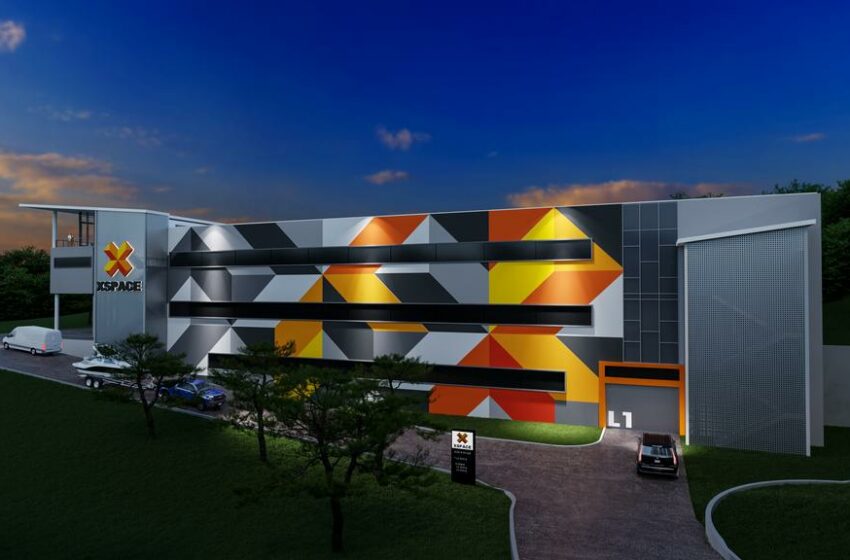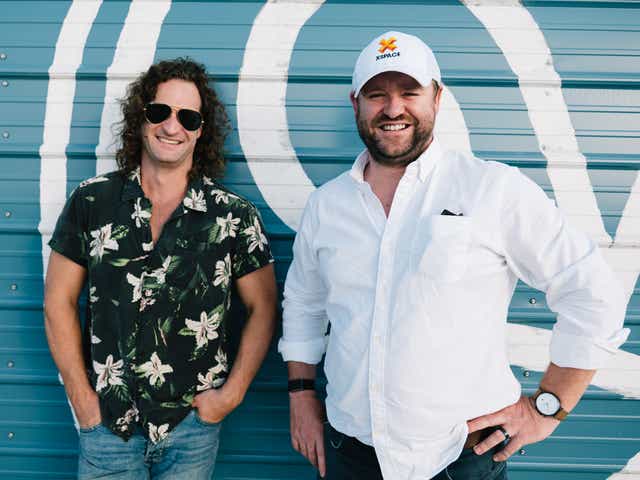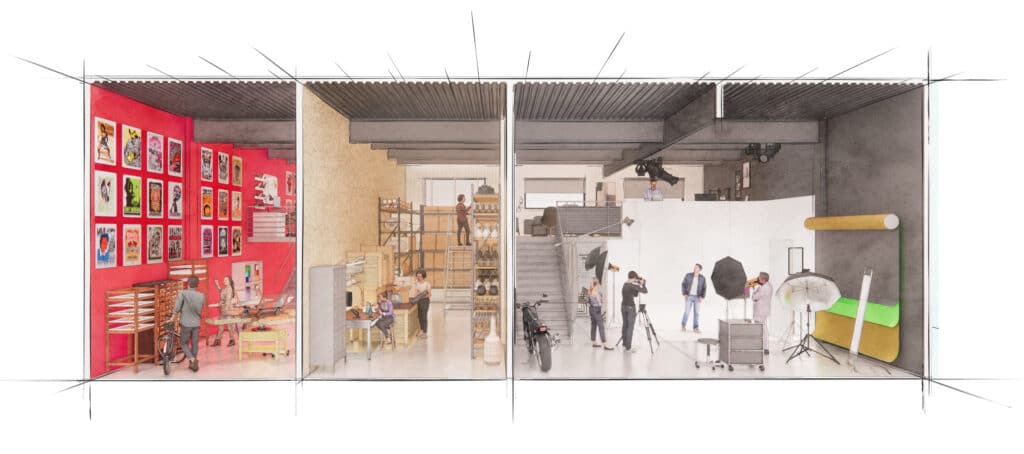Why Texas? Byron Smith on Bringing XSpace from Down Under to the Lone Star State

Like so many innovations, XSpace is an amalgam of existing concepts fused into something fresh, exciting, and new. The company, which started in Australia and is currently erecting its first stateside building outside Austin, offers commercial condominiums that are part workspace, part showroom, part storage unit—and totally adaptable to the passions and projects of their owners.
XSpace’s Australian cofounders, Byron Smith and Tim Manson, are currently overseeing the construction of a 100,000-square-foot building in Lakeway, near Mansfield Dam. When completed, the building’s 106 XSpace units will offer high-end, highly customizable spaces that individual owners can use as they see fit—whether it’s home base for a business, a next-level “man cave” or “she shed,” or storage for a classic car collection. (It doesn’t hurt that buying an XSpace also gives owners an affordable foothold in the skyrocketing Central Texas real estate market.)

When Byron and Tim decided to bring the XSpace concept from Australia, where it’s already seen success, to the United States, they didn’t start in Texas. But they got here quickly. I recently spoke with Byron about what drew them to their new home in Austin and how they’re marketing this inventive new condo concept to the community.
—Ed Curtis
Ed Curtis: How did XSpace get started?
Byron Smith: My partner and I developed the XSpace concept in Australia over 15 years. It started as iSpace, which was a strictly commercial product with smaller unit sizes than we offer now. Over time, it evolved into the mix of commercial and personal-use tenants we have now with XSpace. But it’s a proven formula with an established market in Australia. We’re now adapting it to the American marketplace and really elevating the concept. One of the key things we’re adding is a 3,000-square-foot lounge at the top of the building. We don’t do that in Australia, but it cements the sense of community we’re trying to build.
Curtis: How and why did you choose Texas for this first US XSpace?
Smith: Early in the transition to the US, [XSpace cofounder Tim Manson] and I were based in Los Angeles and New York respectively. It soon became apparent that running the business from those cities was prohibitive, both monetarily and in getting people’s buy-in. I called up Tim and said, “I think we need to get to Texas.” Once we drove through Austin, we had a gut reaction. We both said, “I think this is where we need to be.” We realized that this is a place that embraces innovation and new ideas, and that’s where we want to be.
Then, when we saw this site on the Mansfield Dam where we’re currently building the XSpace, we were even more excited. It’s not in a commercial pocket per se, down among warehouses, like we’d build near in Australia. But the demographic is almost identical to what we’ve had success with in Australia.
Curtis: How has the transition to Austin been for you?
Smith: It’s been pretty amazing, actually. The quality of life and the sophistication of the people here make it very exciting. On a personal level, the sun’s always shining and there’s so much commerce. There’s always something new happening.
We’re excited to do three or four more projects in Austin, with many more planned for Texas overall. Our intention is to lay out a big platform across all the major cities in Texas, and then scale it nationally. On a personal and business level, Austin was the best place to do that from. Texas is where we want to do business. We align with a lot of what YTexas is doing, bringing great people and companies here. It’s a natural strategic alignment for us.
As an Australian coming to Texas, there are a lot of shared values and pastimes. From hunting to drinking beer to watching sport to the similar handshake cultures—it was an easy landing pad.
Curtis: I know that XSpace has built a relationship with Roger Clemens. How did that come about?
Smith: We were introduced to Roger socially in our early days in Texas. We told him what we were doing and his eyes lit up. He had a real need for that type of space on a personal level, and he liked that we were doing something big and innovative in Texas. He took a unit on the ground level, where he’s going to showcase his memorabilia and have a base for his charitable organization. Roger has been a great brand ambassador for us. It gives credibility. He’s an example of the high caliber of people who are going to be in each XSpace unit in the building.

Curtis: What other types of people have bought or are considering buying an XSpace unit?
Smith: It’s a varied group. We have one woman who has a thriving miniature cactus business. She wants space for storage and wants a nice mezzanine space for her office—something nicer than a crappy shed in the middle of nowhere, which is usually the alternative.
We’ve also got [former NFL player] Kasey Studdard, who’s going to have a unit for traditional storage and an outlet of his barbecue restaurant, Whitfield’s, onsite. We have a prominent podcaster with many millions of daily listeners, and he wants a space that’s not in his garage. He’s creating a really interesting studio setup. We also have a couple of car enthusiasts. The underlying theme is that we’re creating a blank canvas for people who are pursuing their passions.
Curtis: Can you tell us a little about the construction process itself? I understand that’s somewhat innovative as well.
Smith: Sure. We’re building a three-level building, and on the fourth level will be a business lounge. Each level is 18 feet high, so the building itself is going to be the equivalent of seven stories high, looking down into Lake Travis. It’s going to be an exceptional view, even from the second level.
We’re also using tilt-up construction, which is how we did it in Australia. Basically, it’s a construction method where concrete panels are cast onsite, horizontally, and then tilted up vertically by cranes. It turns out that because of the size of this building—100,000 square feet total—we’re using the largest tilt-wall panels ever erected in Texas. And we’re using local labor and a Texas-based construction company.
Curtis: What can you tell us about the investors in the business you’ve landed so far? How did you go about building those relationships?
Smith: Our investment group was originally led by myself. I think it’s important to put your money where your mouth is. The rest of our capital stack is made up of local high-net-worth individuals who were introduced to us in the early stages of the project, people who were excited about the potential of this innovative project.
Now that we’re in Texas, our investor group is all based here. We’re excited because we can lean on them for local knowledge. They helped us navigate landmines around permitting and fire approval, for example. They’ve also helped us get to know the local community and show them that we’re not just coming here to make a buck. We’re trying to create something that enhances the community and is reflective of it.
I think Texans are about new ideas. This was a new concept to most people, yet we turn up to town and people have backed us. I think that’s reflective of the Texan entrepreneurial spirit.
Curtis: XSpace feels like a unique blend of commercial and personal space. Can you explain how ownership and the HOA works?
Smith: We are very much like a condominium building in the residential sense. People own XSpace units, and then there is jointly owned common space. The only rule is that you can’t live in an XSpace.
With ownership, you also get a sense of pride in the space and a higher caliber of individual who cares about who their neighbors are. That brings the property values up as opposed to something like a month-to-month self-storage unit.
Many people view XSpace as an extension of their house. If you want extra garage space or an office, you can get it—and you now have a real estate asset in Austin. The prices start at $100,000 and go up to $500,000 or $600,0000. It’s a very digestible price point for our customer. One woman bought a unit recently and said, “I want to get on the Austin property ladder. How else can I do that for 200 grand?”

Curtis: As far as finish-out, can owners use their own contractors? What kind of restrictions does the HOA have on that?
Smith: We supply four or five approved contractors should people want to do a fit-out, and there will be exemptions for people who want to bring in their own. We provide things like a mezzanine at an additional cost, which about 90 percent of people have taken us up on. But other than that, it’s a blank canvas. You own that space.
Some people are spending a lot of money, creating their own oasis, almost spending as much on the fit-out as they spent on the unit. It’s a great showcase of what can be done in the units—whatever you can imagine.
Curtis: How many units have you sold so far?
Smith: The number changes daily. We’ve got a huge groundswell of interest at the moment. Pre-construction, we sold 30 percent. Now we’re approaching 50 percent sold. At this rate, we’ll be sold out by the end of the year.
Curtis: What’s your marketing strategy for this project? How are you getting the word out?
Smith: Our marketing strategy is very, very simple: getting out there and engaging with the community and knowing they will sell for us. We’re doing happy hours fortnightly at Steiner Ranch Steakhouse. We want to find out—What do people want to see? What do they not want to see? And people have bought units. They’re bringing friends to the happy hours and saying, “Can we get John in this unit next to me?” It’s a lot of fun.
This XSpace is only special if it’s reflective of the community and embraced by them. So that’s how we’re marketing, face to face with people. No fancy digital stuff.
Curtis: Any advice you have for others looking to relocate to Texas?
Smith: Get here as soon as you can. It’s only going one direction, and good luck if you want to buy a house later, especially in Austin. It’s crazy, but it’s fun. You don’t want to miss the party.






